Oiwi Parker Jones
NeuGPT: Unified multi-modal Neural GPT
Oct 28, 2024Abstract:This paper introduces NeuGPT, a groundbreaking multi-modal language generation model designed to harmonize the fragmented landscape of neural recording research. Traditionally, studies in the field have been compartmentalized by signal type, with EEG, MEG, ECoG, SEEG, fMRI, and fNIRS data being analyzed in isolation. Recognizing the untapped potential for cross-pollination and the adaptability of neural signals across varying experimental conditions, we set out to develop a unified model capable of interfacing with multiple modalities. Drawing inspiration from the success of pre-trained large models in NLP, computer vision, and speech processing, NeuGPT is architected to process a diverse array of neural recordings and interact with speech and text data. Our model mainly focus on brain-to-text decoding, improving SOTA from 6.94 to 12.92 on BLEU-1 and 6.93 to 13.06 on ROUGE-1F. It can also simulate brain signals, thereby serving as a novel neural interface. Code is available at \href{https://github.com/NeuSpeech/NeuGPT}{NeuSpeech/NeuGPT (https://github.com/NeuSpeech/NeuGPT) .}
Resolving Domain Shift For Representations Of Speech In Non-Invasive Brain Recordings
Oct 25, 2024
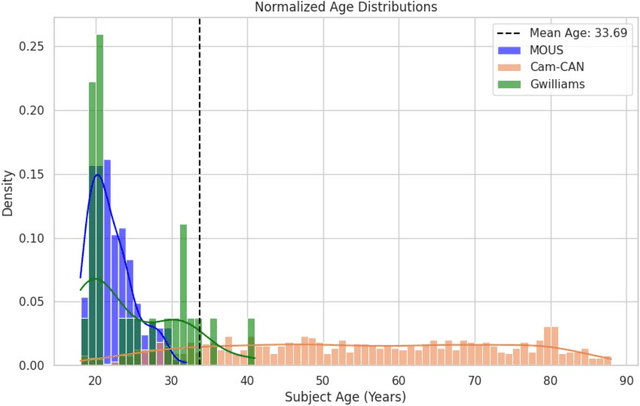
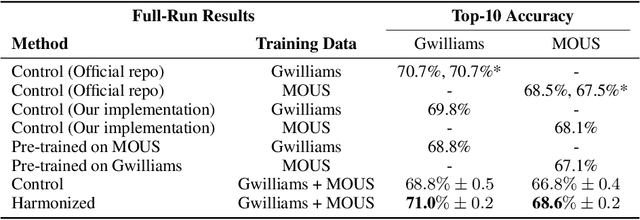
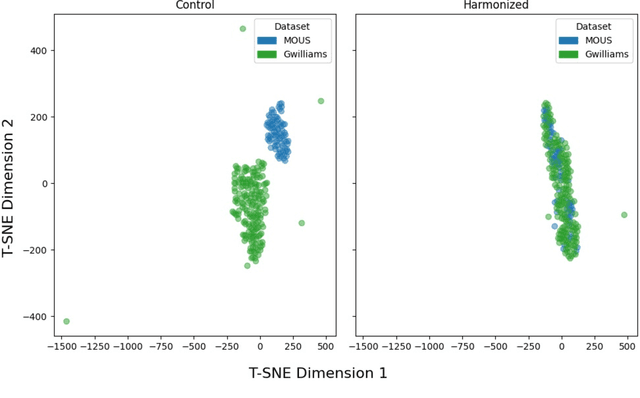
Abstract:Machine learning techniques have enabled researchers to leverage neuroimaging data to decode speech from brain activity, with some amazing recent successes achieved by applications built using invasive devices. However, research requiring surgical implants has a number of practical limitations. Non-invasive neuroimaging techniques provide an alternative but come with their own set of challenges, the limited scale of individual studies being among them. Without the ability to pool the recordings from different non-invasive studies, data on the order of magnitude needed to leverage deep learning techniques to their full potential remains out of reach. In this work, we focus on non-invasive data collected using magnetoencephalography (MEG). We leverage two different, leading speech decoding models to investigate how an adversarial domain adaptation framework augments their ability to generalize across datasets. We successfully improve the performance of both models when training across multiple datasets. To the best of our knowledge, this study is the first ever application of feature-level, deep learning based harmonization for MEG neuroimaging data. Our analysis additionally offers further evidence of the impact of demographic features on neuroimaging data, demonstrating that participant age strongly affects how machine learning models solve speech decoding tasks using MEG data. Lastly, in the course of this study we produce a new open-source implementation of one of these models to the benefit of the broader scientific community.
The Brain's Bitter Lesson: Scaling Speech Decoding With Self-Supervised Learning
Jun 06, 2024Abstract:The past few years have produced a series of spectacular advances in the decoding of speech from brain activity. The engine of these advances has been the acquisition of labelled data, with increasingly large datasets acquired from single subjects. However, participants exhibit anatomical and other individual differences, and datasets use varied scanners and task designs. As a result, prior work has struggled to leverage data from multiple subjects, multiple datasets, multiple tasks, and unlabelled datasets. In turn, the field has not benefited from the rapidly growing number of open neural data repositories to exploit large-scale data and deep learning. To address this, we develop an initial set of neuroscience-inspired self-supervised objectives, together with a neural architecture, for representation learning from heterogeneous and unlabelled neural recordings. Experimental results show that representations learned with these objectives generalise across subjects, datasets, and tasks, and are also learned faster than using only labelled data. In addition, we set new benchmarks for two foundational speech decoding tasks. Taken together, these methods now unlock the potential for training speech decoding models with orders of magnitude more existing data.
Foundational GPT Model for MEG
Apr 14, 2024Abstract:Deep learning techniques can be used to first training unsupervised models on large amounts of unlabelled data, before fine-tuning the models on specific tasks. This approach has seen massive success for various kinds of data, e.g. images, language, audio, and holds the promise of improving performance in various downstream tasks (e.g. encoding or decoding brain data). However, there has been limited progress taking this approach for modelling brain signals, such as Magneto-/electroencephalography (M/EEG). Here we propose two classes of deep learning foundational models that can be trained using forecasting of unlabelled MEG. First, we consider a modified Wavenet; and second, we consider a modified Transformer-based (GPT2) model. The modified GPT2 includes a novel application of tokenisation and embedding methods, allowing a model developed initially for the discrete domain of language to be applied to continuous multichannel time series data. We also extend the forecasting framework to include condition labels as inputs, enabling better modelling (encoding) of task data. We compare the performance of these deep learning models with standard linear autoregressive (AR) modelling on MEG data. This shows that GPT2-based models provide better modelling capabilities than Wavenet and linear AR models, by better reproducing the temporal, spatial and spectral characteristics of real data and evoked activity in task data. We show how the GPT2 model scales well to multiple subjects, while adapting its model to each subject through subject embedding. Finally, we show how such a model can be useful in downstream decoding tasks through data simulation. All code is available on GitHub (https://github.com/ricsinaruto/MEG-transfer-decoding).
Mai Ho'omāuna i ka 'Ai: Language Models Improve Automatic Speech Recognition in Hawaiian
Apr 03, 2024Abstract:In this paper we address the challenge of improving Automatic Speech Recognition (ASR) for a low-resource language, Hawaiian, by incorporating large amounts of independent text data into an ASR foundation model, Whisper. To do this, we train an external language model (LM) on ~1.5M words of Hawaiian text. We then use the LM to rescore Whisper and compute word error rates (WERs) on a manually curated test set of labeled Hawaiian data. As a baseline, we use Whisper without an external LM. Experimental results reveal a small but significant improvement in WER when ASR outputs are rescored with a Hawaiian LM. The results support leveraging all available data in the development of ASR systems for underrepresented languages.
DreamUp3D: Object-Centric Generative Models for Single-View 3D Scene Understanding and Real-to-Sim Transfer
Feb 26, 2024Abstract:3D scene understanding for robotic applications exhibits a unique set of requirements including real-time inference, object-centric latent representation learning, accurate 6D pose estimation and 3D reconstruction of objects. Current methods for scene understanding typically rely on a combination of trained models paired with either an explicit or learnt volumetric representation, all of which have their own drawbacks and limitations. We introduce DreamUp3D, a novel Object-Centric Generative Model (OCGM) designed explicitly to perform inference on a 3D scene informed only by a single RGB-D image. DreamUp3D is a self-supervised model, trained end-to-end, and is capable of segmenting objects, providing 3D object reconstructions, generating object-centric latent representations and accurate per-object 6D pose estimates. We compare DreamUp3D to baselines including NeRFs, pre-trained CLIP-features, ObSurf, and ObPose, in a range of tasks including 3D scene reconstruction, object matching and object pose estimation. Our experiments show that our model outperforms all baselines by a significant margin in real-world scenarios displaying its applicability for 3D scene understanding tasks while meeting the strict demands exhibited in robotics applications.
ObPose: Leveraging Canonical Pose for Object-Centric Scene Inference in 3D
Jun 07, 2022


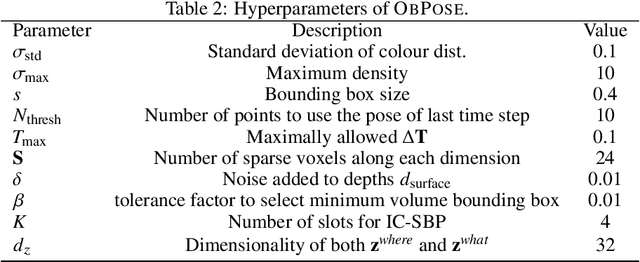
Abstract:We present ObPose, an unsupervised object-centric generative model that learns to segment 3D objects from RGB-D video in an unsupervised manner. Inspired by prior art in 2D representation learning, ObPose considers a factorised latent space, separately encoding object-wise location (where) and appearance (what) information. In particular, ObPose leverages an object's canonical pose, defined via a minimum volume principle, as a novel inductive bias for learning the where component. To achieve this, we propose an efficient, voxelised approximation approach to recover the object shape directly from a neural radiance field (NeRF). As a consequence, ObPose models scenes as compositions of NeRFs representing individual objects. When evaluated on the YCB dataset for unsupervised scene segmentation, ObPose outperforms the current state-of-the-art in 3D scene inference (ObSuRF) by a significant margin in terms of segmentation quality for both video inputs as well as for multi-view static scenes. In addition, the design choices made in the ObPose encoder are validated with relevant ablations.
Generalizing Brain Decoding Across Subjects with Deep Learning
May 27, 2022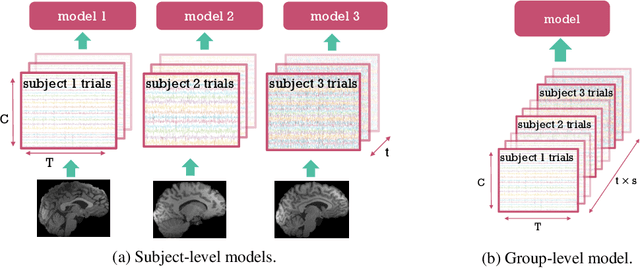

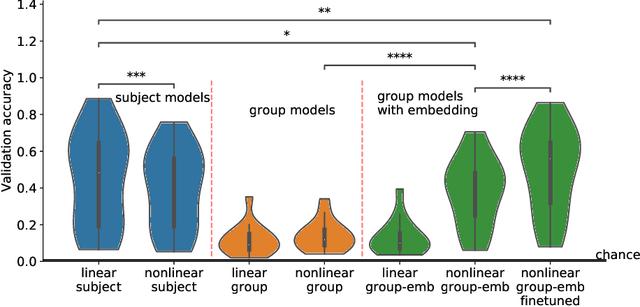
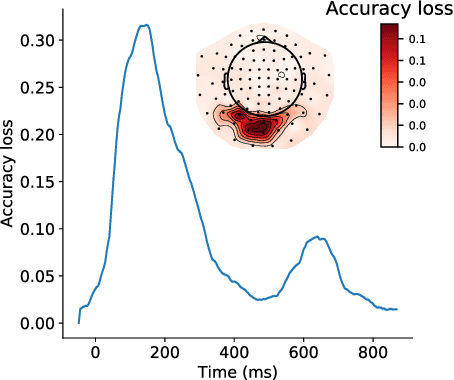
Abstract:Decoding experimental variables from brain imaging data is gaining popularity, with applications in brain-computer interfaces and the study of neural representations. Decoding is typically subject-specific and does not generalise well over subjects. Here, we investigate ways to achieve cross-subject decoding. We used magnetoencephalography (MEG) data where 15 subjects viewed 118 different images, with 30 examples per image. Training on the entire 1s window following the presentation of each image, we experimented with an adaptation of the WaveNet architecture for classification. We also investigated the use of subject embedding to aid learning of subject variability in the group model. We show that deep learning and subject embedding are crucial to closing the performance gap between subject and group-level models. Importantly group models outperform subject models when tested on an unseen subject with little available data. The potential of such group modelling is even higher with bigger datasets. Furthermore, we demonstrate the use of permutation feature importance to gain insight into the spatio-temporal and spectral information encoded in the models, enabling better physiological interpretation. All experimental code is available at https://github.com/ricsinaruto/MEG-group-decode.
VAE-Loco: Versatile Quadruped Locomotion by Learning a Disentangled Gait Representation
May 02, 2022



Abstract:Quadruped locomotion is rapidly maturing to a degree where robots now routinely traverse a variety of unstructured terrains. However, while gaits can be varied typically by selecting from a range of pre-computed styles, current planners are unable to vary key gait parameters continuously while the robot is in motion. The synthesis, on-the-fly, of gaits with unexpected operational characteristics or even the blending of dynamic manoeuvres lies beyond the capabilities of the current state-of-the-art. In this work we address this limitation by learning a latent space capturing the key stance phases constituting a particular gait. This is achieved via a generative model trained on a single trot style, which encourages disentanglement such that application of a drive signal to a single dimension of the latent state induces holistic plans synthesising a continuous variety of trot styles. We demonstrate that specific properties of the drive signal map directly to gait parameters such as cadence, footstep height and full stance duration. Due to the nature of our approach these synthesised gaits are continuously variable online during robot operation and robustly capture a richness of movement significantly exceeding the relatively narrow behaviour seen during training. In addition, the use of a generative model facilitates the detection and mitigation of disturbances to provide a versatile and robust planning framework. We evaluate our approach on two versions of the real ANYmal quadruped robots and demonstrate that our method achieves a continuous blend of dynamic trot styles whilst being robust and reactive to external perturbations.
Next Steps: Learning a Disentangled Gait Representation for Versatile Quadruped Locomotion
Dec 09, 2021



Abstract:Quadruped locomotion is rapidly maturing to a degree where robots now routinely traverse a variety of unstructured terrains. However, while gaits can be varied typically by selecting from a range of pre-computed styles, current planners are unable to vary key gait parameters continuously while the robot is in motion. The synthesis, on-the-fly, of gaits with unexpected operational characteristics or even the blending of dynamic manoeuvres lies beyond the capabilities of the current state-of-the-art. In this work we address this limitation by learning a latent space capturing the key stance phases constituting a particular gait. This is achieved via a generative model trained on a single trot style, which encourages disentanglement such that application of a drive signal to a single dimension of the latent state induces holistic plans synthesising a continuous variety of trot styles. We demonstrate that specific properties of the drive signal map directly to gait parameters such as cadence, foot step height and full stance duration. Due to the nature of our approach these synthesised gaits are continuously variable online during robot operation and robustly capture a richness of movement significantly exceeding the relatively narrow behaviour seen during training. In addition, the use of a generative model facilitates the detection and mitigation of disturbances to provide a versatile and robust planning framework. We evaluate our approach on a real ANYmal quadruped robot and demonstrate that our method achieves a continuous blend of dynamic trot styles whilst being robust and reactive to external perturbations.
 Add to Chrome
Add to Chrome Add to Firefox
Add to Firefox Add to Edge
Add to Edge